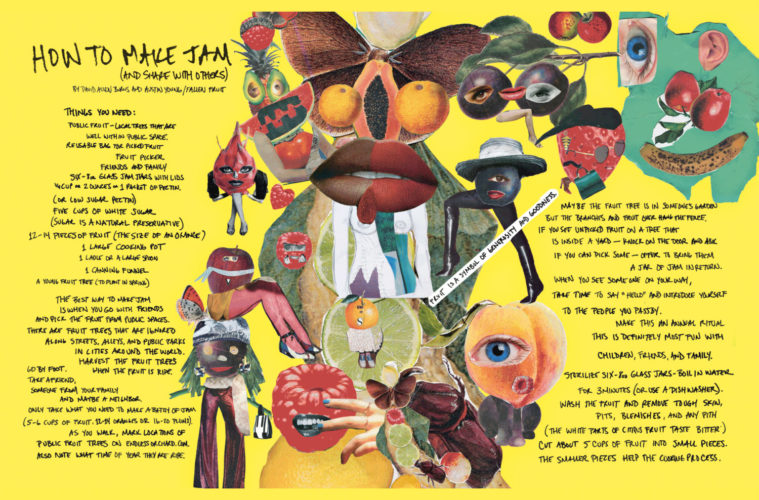Talented chefs are frequently referred to as “artists in the kitchen.” But every now and then, all it takes is one artist in the kitchen, creating food, or thinking about and illustrating food in creative, spiritual, narrative, documentary, aesthetic, or even portraiture, or thinking about the significance of food in their own ancestry, or pursuing a visually arresting, narrative-rich perspective on centuries of world history that begins with breakfast. These three beautiful books contain recipes for the art-loving foodies in your life.
The Kitchen Studio: Culinary inventions by artisans (Phaidon)
Is it a recipe book or an art book? That applies to both and neither. A journal, a notepad, a book with bound pages… At The Kitchen Studio, more than 70 contemporary artists from all over the world and spanning a wide range of styles and genres analyze their personal ties with food through words and photographs. Some of visual art’s most intriguing characters offer not only recipes (with varied degrees of functional precision ranging from hyper-detail to abstract gesture), but also visuals ranging from crisp, colorful food porn to interpretive evocation and stage directions. Painting, photography, performance art, sculpture, design, social practice, video, and conceptualism are all possibilities (pun intended). Each artist reveals a little bit about themselves as people and artists in ways that are both on brand and entirely unexpected.
Vik Muniz (Ravioli all’Uovo, a notoriously difficult recipe to master, alongside some Picasso still life paintings of meals); Eamon Ore-Giron (Pachamanca—The Northern Soul Remix, a step-by-step ceremonial guide to community cooking); Martha Rosler (Pachamanca—The Northern Soul Remix); Lyle Ashton Harris (Lyle’s Greens, dedicated to his grandmother); Charles Gaines (Southern-Style (Guacamole, decolonialized).
Embrace by Rohina Hoffman (In Appreciation and Generation 1.75). (From Schilt Publishing)
Photographer Rohina Hoffman delves into various aspects of her family’s past and present through a nuanced, poetic analysis of that most universal of languages—food. With Embrace, Hoffman combines two photographic projects—In Gratitude and Generation 1.75—into a metaphorical journey connecting her ancestors to daily routines and family feasts. Caleb Cain Marcus carefully planned this journey. Rohina, an American citizen born in India in 1968, was raised by her grandparents until she was five years old, when she was reunited with her parents. Generation 1.75’s literary discourse is about the in-between identity of being neither first nor second generation, steeped in remembrance of previous eras and places while staying entirely American. Despite the fact that In Gratitude is much more substantial, family still takes center stage.
Hoffman did what every artist was forced to do during the pandemic’s first and continuing lockdown period: express and process their experiences with whatever materials were available, devising unique ways to convey the wildest story in the universe. Hoffman made food and family the literal and symbolic topics of her photographs and narrative. Hoffman played a cute game of dress-up and mindful dining with her husband and children before having them pose ceremoniously while still holding a single component of their evening meal in its whole, natural magnificence.
A solitary luscious peach and a vibrant, upbeat animal pattern with a “do I dare” neckline; scraggly, green-leafed, pendulous beets and a man in pastel hospital scrubs; a wiccan bouquet of prickly rosemary and a female with a bright and clear aura; a luscious squash and a woman wrapped in a comfortable cashmere shawl; foolish, sunny carrots against a gingham dress and thick woolen socks
Tasting History: Explore the Past by Max Miller Recipes from the Past 4,000 Years (Simon & Schuster)
Max Miller, like many (maybe most) individuals, went down some fairly deep internet rabbit holes as a result of lockdown boredom and a pandemic job slowdown. In his instance, esoteric food history was arcane, strange, surprising, and fascinating. Miller, like many others, began cooking. But what sets him apart is the masterful way he combined these elements into a single concept: exploring the vast world of global culinary history through not only diligent research, but also devoted re-creation—sourcing as close to original artisanal and legacy ingredients as possible, but proceeding with modern culinary tools and gadgets. When he posted everything to YouTube, the rest of the at-home, binge-watching, food-curious aesthetes could follow along. Max Miller’s Tasting History had nearly two million subscribers after three years.
Miller cheerfully and with obvious passion shares not only his experiments (some more successful than others) but also his research when contextualizing his cooking within what he discovered along the way about the people, culture, art, holidays, religious and other observations, global trade exploits, and agriculture that gave rise to the culinary traditions he revisits. Similar to Julie and Julia with a dash of Indiana Jones (or perhaps National Treasure), but Miller also discusses his experiments and findings. Miller chose 60 of the most popular and appetizing recipes from the series for the lavishly illustrated book version, presenting the originals with his own modern interpretations. The dishes cover a wide range of historical periods, including ancient Rome and its European and North African influences, the agrarian Middle Ages in Europe, the courtly Renaissance, and the fusion cuisines born of empire and immigration.
Soul Cakes, a yeasted bun with currants from around 1600, Pumpkin Tourte, a crustless pumpkin cheesecake with cinnamon and sugar beloved since 1570, pancakes that haven’t changed much since 1658 (don’t mess with perfection), and samosas that have been making mouths water since 1590 are just a few examples. With exquisite imagery and precise historical artwork, the book (and films) are the ultimate way to bring history to life, both in your head and on your taste.
